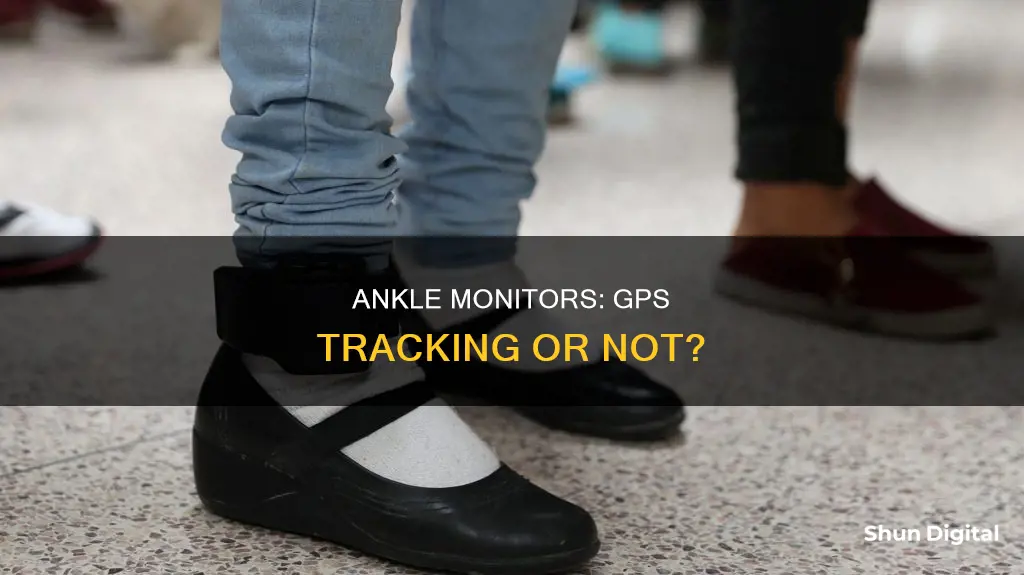
Ankle monitors are often used as an alternative to incarceration, allowing individuals to maintain a sense of freedom while being monitored by authorities. These devices are typically used for individuals who are awaiting trial, on probation or parole, or facing immigration proceedings. While not all ankle monitors have GPS, this technology has become increasingly common and offers several benefits, such as reducing jail overcrowding and costs, and promoting rehabilitation and reintegration into society. GPS ankle monitors utilize satellite technology to track an individual's movements and can be programmed with specific boundaries or zones that, if violated, trigger an alert to monitoring stations.
| Characteristics | Values |
|---|---|
| Purpose | To monitor individuals who are subject to legal restrictions, allowing authorities to keep track of them without the need for incarceration |
| Use Cases | People awaiting trial, serving probation and parole, facing immigration proceedings, house arrest, community control, or those deemed a flight risk |
| Technology | Utilizes GPS technology, often in conjunction with radio frequency (RF) signals, to track the wearer's movements and location |
| Components | GPS module, cellular module for data transmission, and an electronic strap for secure attachment |
| Software | Sophisticated software system that manages data collection and analysis, generating reports or alerts for law enforcement |
| Communication | Relies on cellular networks and nearby cell towers to transmit location data to monitoring stations and centers for analysis |
| Alerts | If the wearer violates a predefined boundary or attempts to remove/damage the device, an alert is triggered and sent to monitoring stations and law enforcement |
| Charging | Individuals wearing the ankle monitor are typically responsible for charging the device regularly through a power outlet |
| Benefits | Reduces jail overcrowding and costs, promotes rehabilitation and reintegration by allowing individuals to maintain daily routines and employment |
| Concerns | Legitimate privacy concerns, stigma, social isolation, and stress for wearers; may exacerbate systemic inequities related to race, class, and disability |
What You'll Learn

How do GPS ankle monitors work?
GPS ankle monitors are used to allow the corrections system to monitor offender behaviour without requiring full-time incarceration. They are often used as an intermediate step between probation and prison, allowing the wearer to maintain some semblance of a normal life while restricting their activities.
GPS ankle monitors use Global Positioning System Technology to track the wearer's location. The device contains a GPS receiver that detects signals from the network of GPS satellites in orbit, providing a pinpoint location approximately once a minute. This data is then transmitted via a cellular connection to a central monitoring hub, giving the corrections department a real-time picture of the wearer's movements. This central monitoring hub uses software tools to help officers identify and address issues in their caseload. For example, Google Maps and Google Info windows can be built into the monitoring software, allowing officers to quickly identify a client’s exact location and easily understand their movements.
GPS ankle monitors can also be used in conjunction with geofencing technology to define restricted areas for the wearer. This technology allows the wearer to go wherever they want within a certain radius of a set location, such as their home. The system will send out an alert if the wearer ventures outside of this radius. Other locations, such as work or school, may be set as acceptable destinations, and the permitted radius may vary from day to day or hour to hour. In some cases, GPS ankle monitors may also be used to enforce restraining orders, with alarms sounding if the wearer approaches the victim's home or workplace.
In addition to location tracking, GPS ankle monitors can also include other features such as alcohol monitoring, where the device periodically monitors the wearer's sweat to determine if they remain sober. They may also include a two-way communication system, allowing correctional officers to warn the wearer if they approach the limit of their safe zone or enter a restricted area.
Disabling Ankle Monitors: A Step-by-Step Guide
You may want to see also

Who uses GPS ankle monitors?
GPS ankle monitors are used by people who are subject to legal restrictions. They are often used as an alternative to incarceration, allowing individuals to remain free while awaiting trial or serving their sentences outside of traditional correctional facilities. This is especially common for non-violent offenders.
GPS ankle monitors are typically used for individuals who are deemed a flight risk or a danger to the community. They are also used for those who are considered low-risk offenders, such as DUI or DWI defendants, as an alternative to pre-trial detention or as a condition of probation. In some cases, they can be used to reduce an individual's bail amount.
GPS ankle monitors are also employed in immigration cases, where individuals awaiting court dates for immigration proceedings may be required to wear them.
Additionally, GPS ankle monitors are used in cases of domestic violence to ensure that the offender maintains a required distance from the victim.
For high-risk clients requiring constant location monitoring, GPS ankle monitors offer enhanced supervision and ensure that individuals do not leave approved areas. They are also used to monitor sex and violent offenders, providing an extra layer of supervision to prevent further offenses.
Overall, GPS ankle monitors are a tool to ensure public safety, promote rehabilitation, and reduce jail overcrowding and costs.
Monitoring Data Usage: Xfinity Router Guide
You may want to see also

What are the benefits of GPS ankle monitors?
GPS ankle monitors are a common tool in today's justice system, offering numerous benefits to authorities, offenders, and society as a whole. Here are some of the key advantages:
Enhanced Supervision and Safety:
GPS ankle monitors provide authorities with superior location accuracy and tracking capabilities. This enables officers to effectively supervise high-risk individuals, such as sex offenders, violent offenders, and those involved in domestic violence cases. By knowing the exact location of these individuals, officers can quickly address any issues and ensure they are adhering to the set restrictions. This enhanced supervision contributes to improved community safety and helps prevent further crimes.
Alternative to Incarceration:
GPS ankle monitors offer a viable alternative to traditional incarceration, particularly for non-violent offenders. This approach helps alleviate jail overcrowding and reduces the costs associated with incarceration. Offenders can serve their sentences while remaining in their communities, allowing them to maintain employment, improve social and vocational skills, and work towards rehabilitation and successful reintegration into society.
Real-time Monitoring and Alerts:
GPS technology provides officers with instant access to an individual's travel details and movement patterns. Through features like geo-fencing, authorities can establish virtual boundaries for the wearer, receiving immediate alerts if these boundaries are violated. This real-time monitoring enables prompt responses to potential violations, ensuring compliance with court-imposed restrictions and enhancing public safety.
Risk Reduction and Easy Tracking:
GPS ankle monitors reduce the risk of bail bond forfeiture by making it easier to track and locate defendants who decide to flee. This provides assurance that defendants will appear for their court proceedings, reducing the financial burden on bondsmen and increasing the likelihood of justice being served.
Cost Savings and Efficiency:
The use of GPS ankle monitors can lead to cost savings for the justice system by reducing the need for incarceration. Additionally, GPS analytics streamline the caseload management process for officers, allowing them to quickly identify patterns and make sense of client movements without having to review each data point individually. This saves time and resources, enabling officers to focus on tasks that require more attention.
Removing Philips Monitor Stand: A Step-by-Step Guide
You may want to see also

What are the drawbacks of GPS ankle monitors?
GPS ankle monitors are often used as an alternative to jail time, allowing individuals to remain free while awaiting trial or serving probation. However, there are several drawbacks and concerns associated with their use.
One significant drawback is the financial burden placed on the wearer. The cost of renting and using GPS ankle monitors can be substantial, with daily fees ranging from $3 to $35, in addition to initial setup charges that can reach $100 to $200. These expenses can be particularly challenging for individuals and families already facing financial difficulties due to incarceration.
Another drawback is the restriction on movement and the potential for false alerts. GPS ankle monitors are designed to track the wearer's location and ensure they stay within designated areas. However, technical glitches and poor cellular reception can lead to false alerts, causing unnecessary stress and, in some cases, even resulting in the wearer being sent back to jail. The constant monitoring and restrictions on movement can also lead to social isolation, stigma, and mental health issues such as depression and anxiety for the wearer.
Furthermore, GPS ankle monitors have been criticised for exacerbating systemic inequities, particularly along lines of race and class. For example, studies have shown that Black individuals are more likely to be subjected to electronic monitoring than their white counterparts.
Additionally, there are concerns about the accuracy and reliability of GPS technology. While GPS ankle monitors can provide superior location accuracy, technical problems such as equipment malfunction, loss of signal, power outages, and battery failures are common. These issues can lead to disruptions in the wearer's life, causing them to lose jobs and miss important family events.
Lastly, the use of GPS ankle monitors has been questioned in terms of their effectiveness in ensuring court appearances, protecting public safety, and rehabilitating offenders. While they are intended to reduce recidivism and provide structure, some studies suggest that the benefits may not outweigh the costs.
In conclusion, while GPS ankle monitors offer an alternative to incarceration, they also present several drawbacks and concerns that need to be addressed to ensure fairness and effectiveness in the criminal justice system.
Understanding ASUS CPU Temp Monitoring: What's Really Going On?
You may want to see also

What are the rules for wearing a GPS ankle monitor?
When ordered to wear a GPS ankle monitor, there are several rules that must be followed to avoid additional charges and penalties. Here are the key rules to remember:
Do Not Remove or Tamper with the Device
It is a severe offence to remove or tamper with the GPS ankle monitor in any way. This includes trying to damage or disable it. If you attempt to do so, the device will automatically send a signal to law enforcement agencies, and you may face further charges.
Stay Within Specified Areas
You must not go outside the areas you are allowed to be in. The monitor will vibrate and emit a loud tone if you go near the boundary of the designated area. If you do not return to the area, the device will send an alert to the authorities, resulting in an automatic violation.
Comply with Additional Rules
You must comply with any other rules set by the court or your probation officer. These may include:
- Curfews or other restrictions
- Regular check-ins with your probation officer
- Abstaining from drugs and alcohol
- Avoiding certain people or locations
- Maintaining a certain distance from a victim or witness
Keep the Monitor Charged and in Good Condition
It is your responsibility to ensure the monitor is charged and functioning properly. You may be required to charge it daily or as directed. You should also ensure it is not damaged and that the batteries are working correctly.
Get Approval for Travel
If you need to travel outside the specified area, you must get prior approval from your probation officer.
Notify of Any Changes
You should notify your probation officer of any changes to your contact information, such as a new phone number or address.
Comply with Installation and Removal
You must comply with the installation process and only have the device removed by an authorised person on the court-approved date.
In summary, wearing a GPS ankle monitor requires strict adherence to the rules set by the court and your probation officer. These rules are in place to ensure your compliance with the conditions of your release or probation, and any violation can result in serious consequences.
Understanding LCD Monitor White Dots: Causes and Fixes
You may want to see also
Frequently asked questions
An ankle monitor is a device that courts use as a substitute for harsher penalties, such as incarceration. It is typically worn when a defendant is on house arrest, probation, or parole, or prior to going to trial.
Ankle monitors use GPS technology to track the wearer's movements and position. They receive signals from multiple GPS satellites orbiting the Earth and analyse the timing and strength of these signals to estimate the distance between the wearer and each satellite.
Ankle monitors provide an alternative to incarceration, allowing non-violent offenders to serve their sentences outside of traditional correctional facilities. This helps to reduce jail overcrowding and costs, and can promote rehabilitation and reintegration into society.







